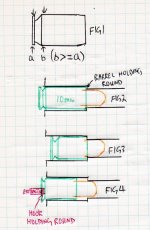OK, I have a little time to do some measurement on 45ACP fitting into my Colt Gold Cup and 9mm into my Glock 26. This is what's happening with a shorter casing fitting into a gun that fit the longer casing but same diameter rounds.
I don't have a gun to measure on .40S&W and 10mm, you guys can try it.
You can see if Fig.1 I measured the 9mm and the 45ACP casing. The diameter of rim (a) and the last part of the casing(b) is very close. I open both my Gold Cup and Glock and I can fit the round the OPPOSITE way with the rim of the casing going in first. I can at least partly fit into the chamber. This means the rim can go into the chamber if the casing is too short.
Now look at Fig.2, the normal way of how a round is loaded into the chamber. The diameter of the chamber is larger than the barrel, so the casing is STOPPED as shown in Fig.2. This is true for my Glock and Colt Gold Cup.
Fig.3 show what happens if you try to fit a short casing 0.40S&W into a 10mm chamber. Since the casing is shorter, it will go all the way in until it hits the end of the chamber where the diameter becomes smaller.......unless something is holding it in place against the breech face. Without that, the firing pin will NOT hit the primmer and the gun won't fire.
Fig.4 The only way you can fire a .40S&W round is something is holding the round against the breech face so the firing pin can reach and hit the primmer to discharge the round. The ONLY thing that hold the shorter .40S&W in place is the
EXTRACTOR. So when the firing pin hits, the strike force is asserted completely on the extractor that is hold the round against the breech face.
This is NOT about experience, this is about science and engineering.
I can say for sure both 45ACP and 9mm works exactly like what I described. This is the same if you try to fire a 380 in a 9mm gun. That will stress the extractor. You guys can do the same measurement like I described if you have the 10mm gun and .40S&W rounds.
With extractor of Glock made of MIM, you'll be taking a big chance. If it is made of forged, then it might be better, but I still won't do it.
Hope this help.

